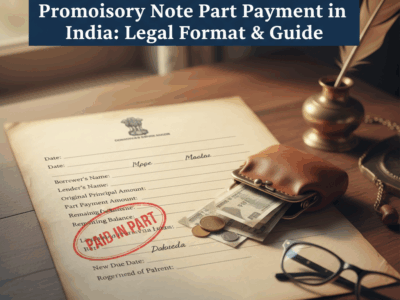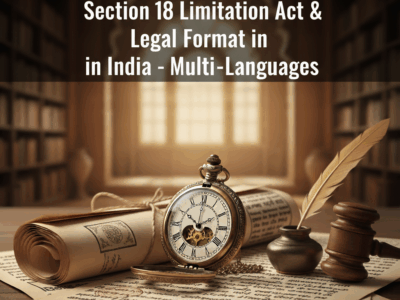Navigating the Acknowledgment of Paternity in India is a critical legal step for establishing a child’s rights and a father’s responsibilities. This legally binding paternity affidavit is more than a simple declaration; it’s the foundational document required for adding a father’s name to a birth certificate, securing a passport, and ensuring inheritance claims. Whether for unmarried parents or in complex family situations, understanding the interplay between a sworn acknowledgment, the stringent rules of Section 112 of the Indian Evidence Act, and modern DNA evidence is crucial. This guide provides a comprehensive analysis of the entire process, complete with a procedural checklist and a legally vetted template to secure your child’s future.
Evaakil.com
Your Guide to Indian LawLEGAL DEEP DIVE
The Acknowledgment of Paternity in India
A Comprehensive Legal and Practical Analysis
Last Updated: October 2025
I. Introduction: The Legal Significance
The act of acknowledging paternity, while seemingly a personal declaration, is a foundational legal step in India. It's not just about stating a biological fact; it’s a critical instrument that establishes a child's legal identity and unlocks a "bundle of rights" essential for their welfare, including inheritance, social security, and insurance benefits. It also imposes the profound legal obligation of financial support upon the father.
This document can be constitutive (creating legal paternity for a child of unmarried parents) or declaratory (confirming paternity already presumed in a marriage). Understanding this dual nature is key to navigating its legal power.
II. The Legal Framework: Paternity vs. Legitimacy
The Cornerstone: Section 112 of the Indian Evidence Act, 1872
Indian law prioritizes legal legitimacy over biological truth, a principle enshrined in the 150-year-old Section 112. It states that a child born during a valid marriage is "conclusive proof" of being the husband's legitimate child. This presumption is a nearly irrebuttable rule of law designed to protect children from the stigma of illegitimacy.
The Power of Section 112: A Visual Guide
START: Valid Marriage Exists
Child is Born During Marriage
How to Challenge?
Invalid Challenges
DNA Test proving otherwise
Wife's proven adultery
Acknowledgment by another man
RESULT: Presumption stands.
The ONLY Valid Rebuttal
Proving "Non-Access"
(Absolute physical impossibility of sexual intercourse)
RESULT: Presumption can be overturned.
The Supreme Court has consistently upheld this principle, stating that in law, "legitimacy is entombed within paternity." The goal is to protect the child and prevent a public trial of the mother's character.
III. The Rise of DNA Evidence: A Legal Tightrope
The advent of DNA testing has introduced a scientific challenge to the legal fiction of Section 112. Courts now walk a tightrope, balancing the "conclusive proof" of legitimacy against scientific certainty. The Supreme Court has laid down strict guidelines for ordering DNA tests in matrimonial and paternity disputes.
When Can a Court Order a DNA Test?
A DNA test is not a routine procedure. It can only be ordered in exceptional cases where a strong *prima facie* case is made to rebut the presumption of legitimacy. The court must be convinced that:
- There is compelling evidence of non-access between the husband and wife during the period of conception.
- The request for a DNA test is not a "roving inquiry" to question the mother's chastity.
- The potential benefit of discovering the biological truth outweighs the harm of "bastardizing" the child and the invasion of privacy.
In *Aparna Ajinkya Firodia vs. Ajinkya Arun Firodia*, the Supreme Court held that children have a right not to have their legitimacy questioned frivolously. Ordering a DNA test mechanically violates the child's right to privacy and identity. The presumption under Section 112 can only be displaced by a high degree of proof of non-access.
IV. Drafting a Legally Enforceable Affidavit
A simple declaration is legally insufficient in India. The document must be a formal affidavit, executed on stamp paper and notarized. The provided user document is critically deficient as it lacks the proper format, notarization, and key factual statements about the mother's marital status.
Comparison: Simple Declaration vs. Legal Affidavit
| Component | User's Declaration (Deficient) | Legal Affidavit (Required) |
|---|---|---|
| Format | Simple Declaration | Sworn Affidavit under oath |
| Stamp Paper | Absent (Invalidates document) | Mandatory (Value varies by state) |
| Notarization | Absent (No legal weight) | Mandatory (Attested by Notary Public) |
| Mother's Marital Status | Absent/Vague (Critical legal omission) | Mandatory & Specific Declaration |
| Verification Clause | Absent | Mandatory legal closing |
Interactive Chart: State-wise Stamp Duty for Affidavits (₹)
Consequences of a False Acknowledgment
Knowingly making a false declaration in a sworn affidavit is a serious criminal offense under the Indian Penal Code, 1860. The consequences can include:
- Section 193 (Perjury): Imprisonment for up to seven years and a fine for intentionally giving false evidence in a judicial proceeding.
- Fraud and Cheating: If the false acknowledgment is used to illegally claim property or benefits, it can lead to charges of cheating (Section 420).
- Civil Liability: The person who made the false declaration may be liable for damages to any party who suffered a loss due to the fraudulent claim.
V. Role under Different Personal Laws
India's pluralistic legal system means the affidavit's effect varies based on the family's religion.
Under Hindu Law
The acknowledgment is primarily an evidentiary tool. It doesn't create legitimacy on its own but serves as powerful proof for claims related to inheritance (especially self-acquired property) and maintenance. Section 112 of the Evidence Act remains the paramount rule.
Under Muslim Law (Ikrar-e-nasab)
Here, it's a substantive doctrine of legitimation. A valid acknowledgment (*Ikrar*) can establish legitimacy and a lawful marriage where direct proof is absent. The effects are profound and irrevocable, conferring mutual inheritance rights between the father, child, and mother.
Under Christian Law & Special Marriage Act
For Christians and those married under the secular Special Marriage Act, 1954, the law is similar to Hindu Law. The Indian Succession Act, 1925, governs inheritance. The affidavit acts as strong evidence of paternity, but the conclusive presumption of legitimacy under Section 112 applies to children born within a marriage solemnized under these acts.
VI. Strategic Use Cases of the Affidavit
A well-drafted affidavit is a versatile tool. Click the filters below to explore its practical applications.
Amending Birth Certificates
The most common use. The affidavit is the primary legal document submitted to the municipal registrar to add a father's name to a child's birth certificate, especially for unmarried parents.
Securing Passports for Minors
Essential for navigating Passport Rules. It serves as proof of parentage for joint declarations by unwed parents or as a supporting document for a single parent's application (Annexure 'C').
Claiming Inheritance Rights
A cornerstone document for a child to establish their status as a legal heir, especially to claim a share in a father's self-acquired property if he dies without a will (intestate).
Fulfilling School Admissions
Bridges the documentation gap if the father's name is missing from the birth certificate. It's a widely accepted legal document that satisfies school verification requirements for a smooth admission process.
VII. Judicial Scrutiny & Evidentiary Value
In court, a notarized affidavit is a formal admission, making it very difficult for the father to retract his statement later. However, its power is diminished when it clashes with Section 112.
If an acknowledgment conflicts with the presumption of legitimacy for a child born in a valid marriage, the Supreme Court has unequivocally held that Section 112 will prevail. A DNA test or a third-party acknowledgment cannot dislodge legal legitimacy without first proving the husband's "non-access."
The affidavit holds maximum weight in cases involving unmarried mothers, where it stands as the most definitive evidence of paternity in the absence of a competing legal presumption.
VIII. International & NRI Perspectives
Globalization has added layers of complexity. NRIs and individuals dealing with foreign jurisdictions face unique challenges.
Apostille and Legalization
If the affidavit is executed abroad for use in India (or vice-versa), it must be authenticated. This is typically done through:
- Apostille: For countries that are signatories to the Hague Apostille Convention of 1961. The document is certified by a designated authority in the foreign country, making it valid in India.
- Legalization: For non-signatory countries, this involves a chain of authentication, often starting with a notary, then the foreign ministry, and finally the Indian Embassy or Consulate in that country.
Enforcement of Foreign Judgments
A paternity order from a foreign court is not automatically enforceable in India. It must be filed for execution in an Indian court under the Civil Procedure Code. The Indian court will recognize the foreign judgment unless it was obtained by fraud, is against Indian public policy, or was delivered by a court without proper jurisdiction.
IX. Legal Template: Affidavit of Paternity
This template is a significant improvement over a simple declaration. It is structured as a formal affidavit to be executed on non-judicial stamp paper of the appropriate value and notarized. Please note that this is a general template and may need to be modified based on specific circumstances. Always consult a legal professional.
Affidavit of Paternity (General Template)
ON NON-JUDICIAL STAMP PAPER OF RS. [Insert appropriate value as per state laws]
AFFIDAVIT
I, [Full Name of Father], son of [Father's Name], aged [Age] years, an Indian Inhabitant, residing at [Full Residential Address], do hereby solemnly affirm and declare on oath as under:
1. That I am the Deponent herein and I am fully conversant with the facts and circumstances of the matter and competent to swear this affidavit.
2. I declare that I am the biological father of the minor child named [Full Name of Child], born on [Date of Birth of Child], at [Place of Birth].
3. I declare that the biological mother of the said child is [Full Name of Mother], daughter of [Mother's Father's Name], currently residing at [Mother's Full Address].
4. (Crucial Declaration: Choose the applicable option and delete the other)
(Option A: For Unmarried Mother)
I solemnly affirm that at the time of conception and birth of the said child, the mother, Ms. [Full Name of Mother], was unmarried and had not entered into a valid marriage with any other person.
(Option B: For Married Mother where Section 112 is challenged)
I solemnly affirm that although the mother, Mrs. [Full Name of Mother], was formally married to Mr. [Husband's Name] at the time of the child's conception, the parties to the marriage did not have any access to each other, making cohabitation impossible. (Note: This requires strong independent proof of non-access and should be drafted by a lawyer).
5. That I hereby unequivocally and irrevocably acknowledge the paternity of the said child, [Full Name of Child], and accept all legal rights, duties, and responsibilities associated with being the child's father, including but not limited to maintenance and inheritance.
6. That this affidavit is being made for the purpose of being submitted to the concerned authorities for [State the purpose, e.g., "adding my name as the father in the birth certificate of my child", "applying for a passport for my minor child", etc.] and for all other legal purposes as may be required.
7. That the contents of the above affidavit are true and correct to the best of my knowledge and belief and nothing material has been concealed therefrom.
DEPONENT
(Signature of Father)
[Full Name of Father]
VERIFICATION
Verified at [Place] on this [Day] day of [Month], [Year], that the contents of paragraphs 1 to 7 of the above Affidavit are true and correct to my personal knowledge. No part of it is false and nothing material has been concealed therefrom.
DEPONENT
(Signature of Father)
[Full Name of Father]
Identified by me,
(Signature of Advocate, if any)
BEFORE ME
NOTARY PUBLIC (INDIA)
X. Frequently Asked Questions (FAQs)
Can a father revoke an Acknowledgment of Paternity later?
It is extremely difficult. A sworn affidavit is a formal legal admission. To revoke it, the father would have to prove in court that the acknowledgment was made under fraud, coercion, or a genuine mistake of fact, which is a very high legal burden to meet. For all practical purposes, it should be considered irrevocable.
Is the mother's consent required on the affidavit?
While the father is the primary deponent (the person making the sworn statement), it is highly advisable and often practically required to have the mother's consent. Many authorities, like passport offices, may require a joint affidavit or a separate consent affidavit from the mother. Her consent strengthens the document's validity and prevents future disputes.
Does this affidavit automatically grant the father custody rights?
No. Acknowledging paternity is separate from determining custody. While it establishes the father's legal standing to *seek* custody or visitation rights, it does not automatically grant them. Custody is decided by a court based on the "best interest and welfare of the child," considering various factors including the child's age, parental capabilities, and living arrangements.
XI. Conclusion & Procedural Checklist
Executing an Acknowledgment of Paternity is a significant legal act. A strategic, meticulous approach is essential to ensure its effectiveness.
Execution Checklist: A Step-by-Step Guide
Verify Legal Context
Confirm the mother's exact marital status at the time of conception. Does Section 112 apply?
Gather Information
Collect full names, addresses, DOBs, and Aadhaar numbers for the father, mother, and child.
Purchase Correct Stamp Paper
Check the required value for an affidavit in your state and purchase non-judicial stamp paper.
Draft the Affidavit
Use a legally sound template, ensuring all declarations (especially marital status) are accurate.
Execute & Notarize
Sign the affidavit in the physical presence of a Notary Public. Obtain the mother's signature as a consenting party if possible.






